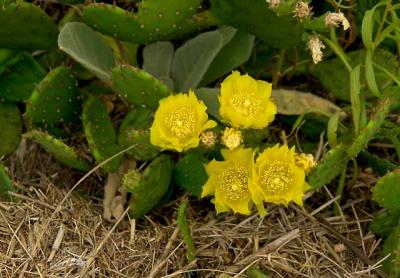Nature Notes: Let It Be

Terry Sullivan called last week from Sag Harbor to tell me that the prickly pear cactus was in bloom along Long Beach Road’s south side. He also mentioned that PSEG has been putting up new utility poles. I’m a stone’s throw away, so I motored over and took a look. Indeed, at least 10 new poles had been erected, each with strange-colored horizontal members on top to which the electrical transmission wires were fastened.
One of the two osprey nests along the road was active. The most easterly one was quiet. On a return trip ospreys sat on both nests. Hopefully the chicks survived the business of the new pole installations.
Today, I was told that PSEG, on recommendation from the Southampton Town Parks Department, had put a temporary hold on replacing more poles until the ospreys were finished and the young could fly. Southampton Town and the Villages of North Haven and Sag Harbor are hosting a renewable energy event on Saturday afternoon at Long Beach featuring electric cars and other non-carbon-fuel electrical devices, but far removed from the two nests.
Apparently, almost six years later, PSEG is getting around to using some of the Federal Emergency Management Agency money accrued in the wake of Superstorm Sandy for “hardening” the electrical infrastructure. Ironically, perhaps, if Sag Harbor, North Haven, and Southampton Town have their way, PSEG will be removing said poles in favor of burying those same transmission lines between Noyac and North Haven.
Revegetation would be part of the overall plan, but after viewing the spectacular yellow prickly pear flowers in bloom, I wonder if such a revegetation plan is warranted. In addition to the prickly pear, there is a host of other native plants along that dune-y stretch, most of which are flowering herbs and grasses, such as American beachgrass, oldfield toadflax, pine-barren sandwort, seaside goldenrod, common milkweed, pinweed, heather, and several natives. Among the native grasses growing there are little bluestem and broomsedge, cordgrass, and saltmarsh hay. Then come the shrubs — the beach plums, Virginia rose, bayberry, and the like — and my favorite plant of all, the hackberry tree, Celtis occidentalis, only one of which still exists there at the edge of the beach parking lot.
Long Beach used to be a narrow isthmus without a road between Noyac and North Haven, and before that, a tombolo, or a spit of land reaching out to the once-inlet from Noyac Bay to Sag Harbor Cove, separating it from the Village of North Haven. Upon his death, Clifford J. Foster left the spit to the Town of Southampton, and a few years back, the beach on Noyac Bay was renamed Foster Memorial Beach in his honor.
The prickly pear cactus, or devil’s tongue, is the only cactus species east of the Mississippi River. It is so scarce in Massachusetts that it is on the state’s endangered list. In Connecticut it is a plant of “special concern.” It ranges here and there throughout Long Island, but mostly sticks to low sandy sites with few trees and enjoys full sun. It ranks among the most beautiful of our wildflowers, but because of its thorny nature it is not widely planted as an ornamental.
The large yellow flowers ultimately become pulpy fruits, somewhat ovoid, and delicious to eat once separated from the spines. The leaf is welded to the stem, forming a flat paddle-shape appendage, and from its tip sprouts the flower, and then the fruit. One of these stem-leaves detached from the root and put into sandy soil with a little moisture takes almost immediately and in a few years becomes a whole patch. The few Native American kitchen middens that I have come across locally, such as one on the edge of Three Mile Harbor, have patches of prickly pear. Apparently, it was cultivated by local Indians.
I snatched a single prickly pear leaf from Long Beach to take to a show-and-tell party held last summer at the headquarters of the Sag Harbor Historical Society on Main Street, just north of the Whaling Museum. I held it up and asked the audience if they knew what it was. A woman sitting in the front row said right off, “Opuntia humifusa,” uttering the scientific name flawlessly to my complete surprise. She was Sharone Einhorn, an ardent conservationist and a board member of the Friends of the Long Pond Greenbelt.
When Julie and I lived in the foothills of Santa Barbara, Calif., my late mother-in-law, Grace Miglioratti, visited us frequently. When she did, she would walk down to the end of Montrose Place where we lived and snatch some prickly pears from a large opuntia of a different species and prepare them in such a way that they were delicious. She called them “figadins.” Strange name, I thought. That was 47 years ago. It was only yesterday that I looked it up in my Italian dictionary and found “fico d’india” or “fig from India.” Opuntia cacti grow all over the world and apparently someone from a city in Croatia across the Adriatic Sea from Italy gave the prickly pear that name a long time ago. A little further research told me that Opuntia ficus-indica, grown commercially in India, is most likely the origin of the Italian word for the prickly pear.
Someone before the turn of the century thought that the somewhat barren strip of land at Long Beach needed trees and a slew of Japanese pines, Pinus thunbergii, were planted. Hit by coastal storm after storm, in particular, during the last 10 years, these pines have mostly died. The isthmus is slowly returning to its original ecotype. As Karen Blumer, the author of “Long Island Native Plants for Landscaping,” espouses, leave it be and it will achieve its original form in time. No revegetation is needed.
Larry Penny can be reached via email at [email protected].
